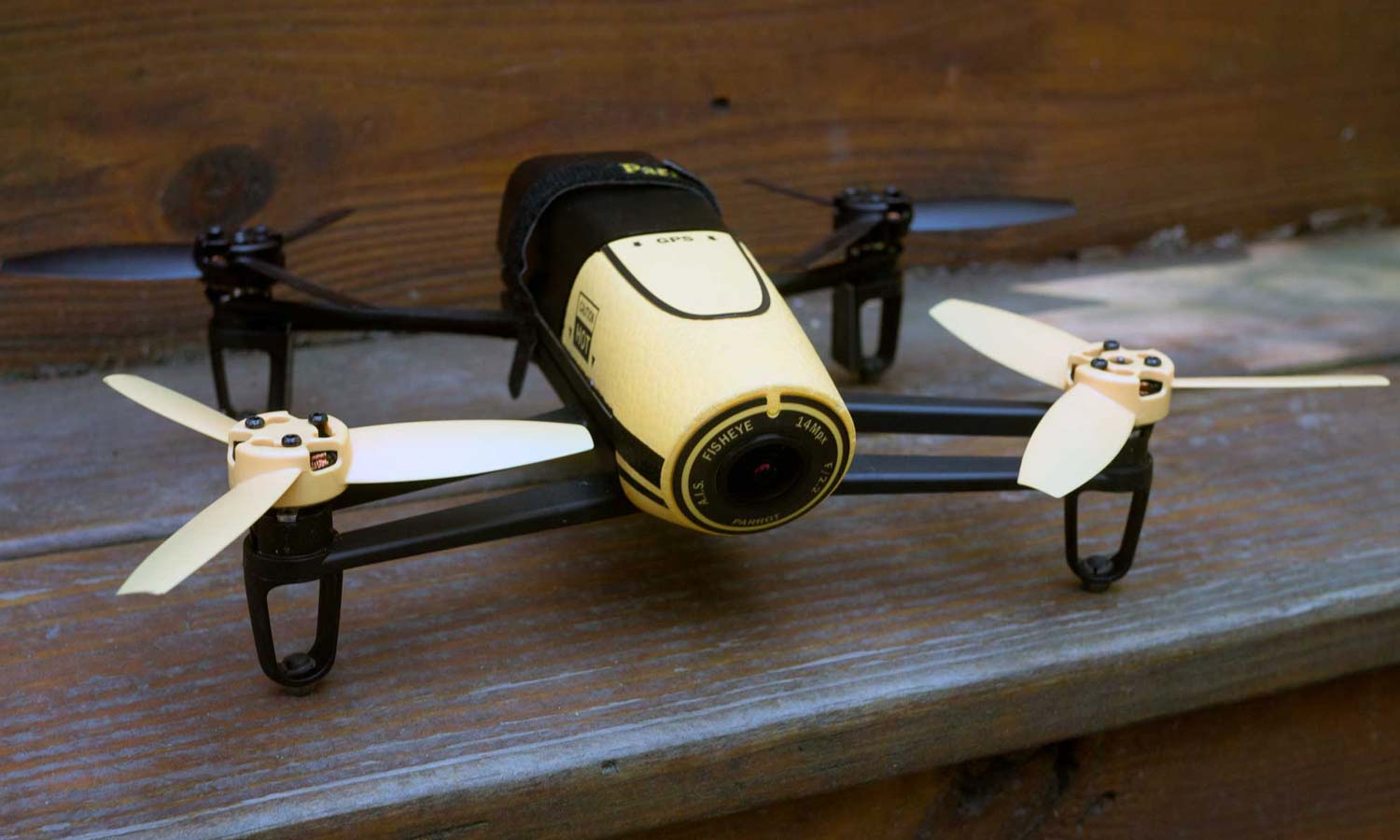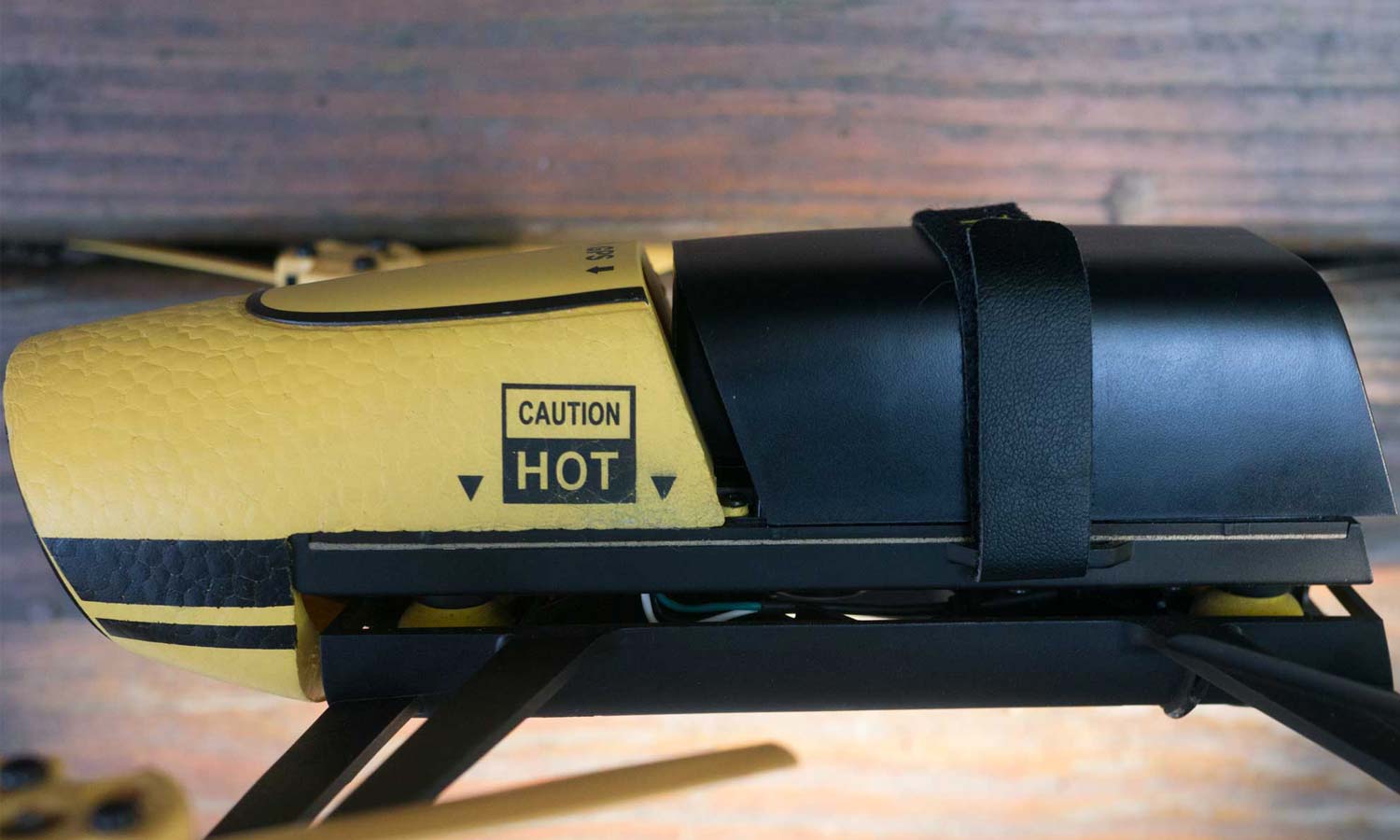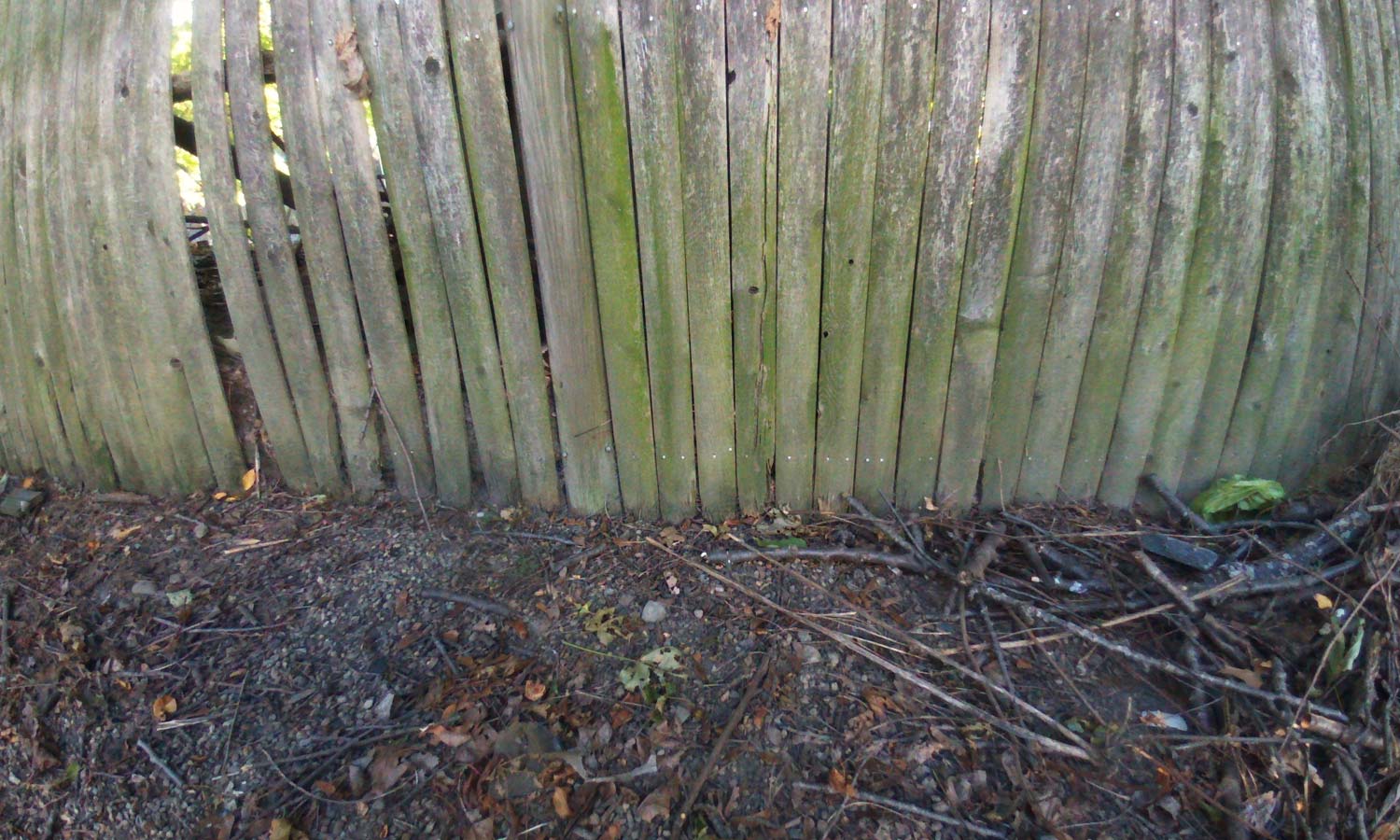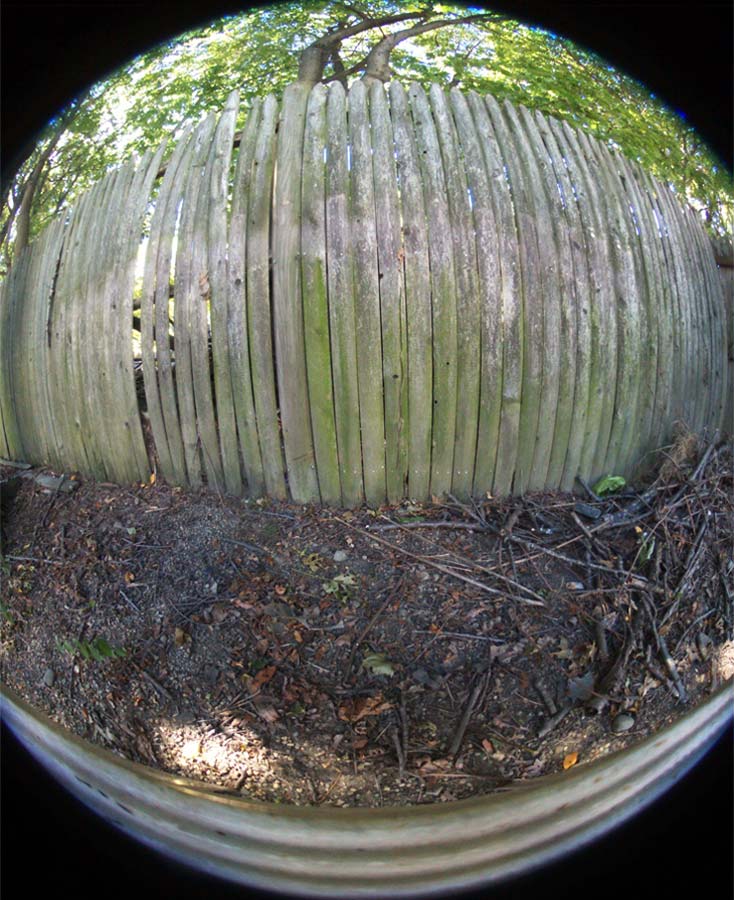Tom's Guide Verdict
A fun-to-fly drone that takes high-quality video and stills, but with an awkward touch-screen controller.
Pros
- +
Phone/tablet control system familiar to non-fliers
- +
Easy to get started
- +
Strong image, video quality
- +
Parts cheap, widely available
Cons
- -
Touch-screen controls lack sensitivity
- -
Short battery life
- -
Long recharging time
Why you can trust Tom's Guide
Parrot helped make drones popular, building quadcopters such as the AR.Drone, which introduced many people to the joys of flying quadcopters with attached video cameras. The new Bebop brings the fun to an audience that's more used to a touch screen than a joystick. And at $499, it is the cheapest way to take decent in-flight video; we just wish the battery lasted longer.
Design
The Bebop looks more like a toy than a serious drone, with a brightly colored body and rotors. But it's built around a solid, tough frame that can take withstand serious crashes and keep flying. Even the rotors are tough: despite numerous collisions with the ground, trees and metal objects, we never needed to swap out the original set.

The camera built into the Bebop's nose is unusual. It has a fisheye lens, which gives it a very wide field of view (about 170 degrees). However, the camera doesn't take fisheye pictures: by default, the output is normal, 12.6-megapixel images or 1080p video.
The Bebop's camera uses the fisheye lens to do a neat trick: it can look sideways, up or down, without moving. This produces level photos and videos while the Bebop is moving, which often involves tilting or tipping. The images and video don't move the same way because the Bebop tips or tilts the view of the camera to compensate. This produces smooth video even during maneuvers. It's rather like having a motorized gimbal, but without the motors.
If your heart’s set on it, you can shoot fisheye still images, but no fisheye video, unfortunately. Put two fingers on the screen and move them, and the camera view pans around without moving the quadcopter. In the Ace control mode, the software adds a second virtual-control stick that does the same thing — useful if you want a specific shot, such as looking down on you from overhead. I used it in the sample video below to get an interesting view of the surface of a river.
The Bebop is a fairly small quadcopter, just under 1 foot square and 4 inches high. The four rotors fit onto the motors at each corner, with the colored rotors indicating the front. The rotors are easy to remove: just snap the included tool into place, twist and they pop off. To replace, place the new rotor on the motor and use the tool to twist and lock it into place.

The Bebop's body has an interesting design, separated into two parts: the base (which connects the spars to the motors) and the electronics. The two parts are held firmly together by four squishy rubber nuts, which stop the motors' vibrations from reaching the electronics and camera. The body feels a little fragile when you first pick it up, as if the two main parts might become easily separated. This didn't happen in our tests, though, despite numerous hard landings and crashes.

The battery fits into the back of the electronics section, latching into place and also being held on by a Velcro strip for good measure. The camera and other electronics are in front, covered by a foam skin. The skin protected the drone well in our tests, but is easily scuffed and discolored. Our test drone was scratched and marked after only a couple of flights.
On the bottom of the base is a small speaker, part of the ultrasonic rangefinder the Bebop uses to find the ground. When you press the Land button, the quadcopter drops, then bounces up slightly when it detects the ground, before settling down to land more softly.
An included set of bumpers clips onto the motors and protects the rotor blades. The bumpers are designed for indoor flying, but the Bebop is a little too large (and noisy) to fly effectively indoors, unless you have access to a sports hall.
Specs
Rotors: 4 (3 blades per rotor), replaceable, 5 inch diameter
Battery Size: 1200 mAh Li-ion polymer (quadcopter),
Battery Life: 10/10 minutes (claimed/tested)
Size: 13 x 12 x 4 inches
Weight: 13.7 ounces
Controller App
The Bebop doesn't come with a dedicated controller. Instead, you install a free mobile app called FreeFlight on your iPad, iPhone or Android phone or tablet. When you connect to the Bebop's Wi-Fi network, the app connects to the quadcopter. You use touch-screen equivalents of the usual sticks for flight controls.
Three control layouts are available: Ace, Normal and Joypad. Joypad will be the most familiar for those who have flown other drones, as it has two virtual-control sticks that involve dragging a dot in a particular direction. The left one controls elevation and rotation, while the right controls forward/back and left/right movement.

Normal mode is different. The left control is for elevation and rotation, while forward/back and left/right is controlled by your mobile device’s accelerometer. Tap and hold the button on the right and tip the device forward, and the Bebop moves forward. Tip your device to the right, and the Bebop slides right. It feels odd at first, but you get used to it quite quickly.
The Bebop can connect to the controller over a 2.4 or 5GHz 802.11 a/b/g/n/ac Wi-Fi connection and will automatically scan and pick a frequency based on the interference it finds. (You can manually select either frequency if required.) It creates its own network, which you have to join: it can't work within an existing wireless network. The network's range depends on the controller device, but we flew the Bebop out to a range of about 100 feet using an iPad Mini on the 2.4GHz frequency before the network started to drop out.
MORE: Best Drones
One thing you cannot do is to password-protect the Wi-Fi network the Bebop creates, which means anyone with a Wi-Fi-enabled device could join the network and interfere with it. Hackers have shown how easy this is to do by creating a software tool that hijacks a Parrot drone. Adding password-protection to the network would make this much harder to do.
The Bebop uses GPS transceivers to navigate, so if it flies out of the controller's range, it will try to fly back to its takeoff position and reacquire the signal.
Flying
Using a phone or tablet is not as precise as using a dedicated controller. There is a small but annoying delay between touching the on-screen controller and the Bebop reacting, and it's hard to do the small, subtle moves that can persuade a quadcopter to move as you want it to. It isn't easy, for instance, to do a very slow pass over something you want to give a long, careful look: The tilt on my iPad Mini moved at a moderate speed, or not at all, with no "very slow" in between.
This may be why Parrot also offers the SkyController, a separate device that wraps around your tablet or phone to look more like a conventional quadcopter remote control. This controller (which costs $799) offers two real control sticks and a more powerful receiver and transmitter, plus an extra antenna that increases the quadcopter's range.
Takeoff and landing are the most dangerous points in any quadcopter's flight, but our Bebop handled them without issues. To take off, you just hit the green takeoff button in the FreeFlight 3 program, and the quad automatically lifts off and hovers about 4 feet above the ground.
The Bebop can also do tricks. Tap the trick button at the top left of the screen, and it produces a drop-down list of flips, somersaults and spins. Select one, and then move the left stick, and the quadcopter performs the trick in the indicated direction. The tricks are impressive, executed quickly in a fairly small space. I wouldn't try them indoors, though, because the quadcopter does not always end up in the same location in which it started. Doing a forward flip, for instance, always seemed to leave the quadcopter about 5 or 6 feet away.
Autonomous Flying
The Free Flight controller app includes a map mode, but it isn't very useful. It shows the positions of you and the drone atop a satellite image that has to be pre-loaded, but you can’t use the map to control the quadcopter. Some more expensive models allow you to set a course on a map, but not the Bebop. Perhaps that isn't surprising, but it's slightly misleading to include a map feature that really can't do anything.
Photos & Video
We were impressed with the clean, sharp and detailed photos and video the Bebop captured. There was a small amount of noise in both stills and footage, though, with a mottled look in some areas of color and a slight stair-step effect in some details (such as the spokes of a bicycle wheel). Still images are captured at an unusual resolution of 4096 x 3220 pixels in both the normal and fisheye modes (see examples below), and videos at a resolution of 1920 x 1080 pixels at 30 frames per second.
Both images and video are stored in the Bebop's 8GB of internal memory, which can't be expanded or replaced. It's enough for about 50 minutes of video, and as long as you move the data off the Bebop between flights, you aren't likely to run out. The video can be transferred wirelessly to the tablet or phone controlling it, or over a USB connection to a PC or Mac.

The Bebop's trick of turning a fisheye image into a more standard-looking one sometimes has consequences. For instance, the curved edges of a fence definitely won't look straight. You can turn this processing off to produce a true fisheye look, although you don't get the full circle of the view — the edges are trimmed off.

When you use the camera's panning feature, images get a little blurry at the edges of the panning range due to the distortion the fisheye lens introduces and the image processing the Bebop does to remove it. This blurring is more noticeable on objects close to the quadcopter, especially on regular shapes.
The Bebop produces good image and video quality, and the camera does a great job of removing the movement of the quadcopter from both. But this process has a cost, and details shot at the extreme edges of the panning range of the camera will get lost.
That isn't a problem with a drone that physically moves the camera, such as the Yuneec Q500 or the DJI Phantom. Both also produce video superior to the Bebop's, with less noise and better detail, although they are much more expensive units.
Repairability
The Bebop is a very repairable drone, with pretty much every part removable and replaceable. A new set of four rotor blades will cost you about $13, and the foam on the body's nose can be replaced for about $10. Even the base of the quadcopter (which might get cracked or broken in a serious crash) can be replaced for about $30. There is also a thriving market of add-on parts, such as domes to protect the camera lens and lights that make it easier to see at night.
Battery Life
The Bebop comes with two 1200mAh batteries, each of which got about 10 minutes of flight in our tests. That's half the flying time we got from larger quadcopters, like the Yuneec Q500, that come with bigger batteries. This was rather frustrating. Ten minutes is long enough for a basic flight, but it doesn't leave you much time to retry a shot or to hover in place for longer video shots. Each battery took about 45 minutes to recharge in the included charger, which could charge only one battery at a time.
MORE: Lily Drone Is a Flying Action Camera That Follows You
The batteries are easy to swap: remove the Velcro strip, slide the battery out and release the cable latch, then reverse those steps to put in a fresh battery. Additional spare batteries cost about $26 each, and some third parties offer higher-capacity batteries (not approved by Parrot) and faster chargers for those who need longer flight times.
A battery-percentage indicator is on the screen of the FreeFlight 3 control app at all times, and a red low-battery warning pops up when it falls to 10 percent. At 4 percent, the quadcopter automatically lands, no matter where it happens to be, so the 10-percent warning is your indication to find a safe spot to land.
Bottom Line
The Bebop is an impressive drone and a great example of how far drone technology has come in recent years. A few years ago, $500 wouldn't even get you a decent remote control, but now it gets you a very capable quadcopter with a very good camera, excellent speed and control and a couple of batteries.
There are compromises, though: Battery life is weak, the mobile-app controller lacks finesse and the camera can produce glitchy images if you push it too far. Most serious fliers will want the SkyController remote, but the Bebop is a simple-to-fly quadcopter that's a lot of fun and takes great video as well.
Richard Baguley has been working as a technology writer and journalist since 1993. As well as contributing to Tom's Guide, he writes for Cnet, T3, Wired and many other publications.
